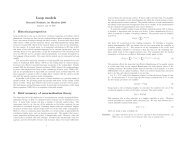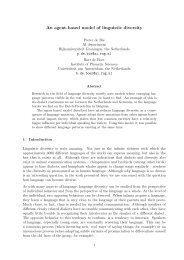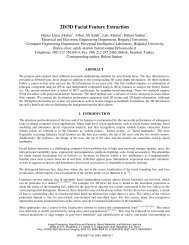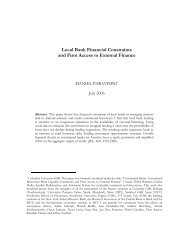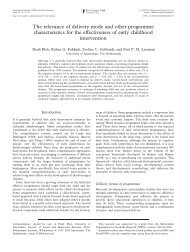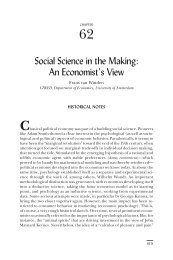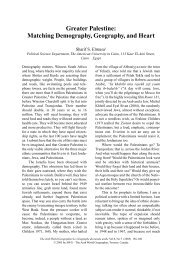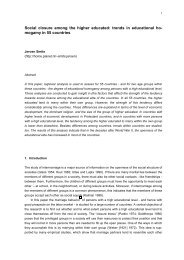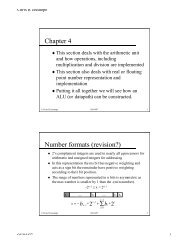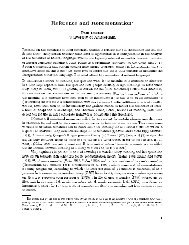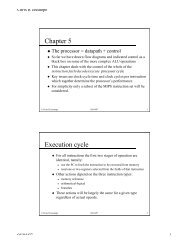Women's Scores on the Sexual Inhibition/Sexual Excitation Scales ...
Women's Scores on the Sexual Inhibition/Sexual Excitation Scales ...
Women's Scores on the Sexual Inhibition/Sexual Excitation Scales ...
Create successful ePaper yourself
Turn your PDF publications into a flip-book with our unique Google optimized e-Paper software.
WOMEN’S SIS=SES SCORES<br />
fact that women and men appear to experience <strong>the</strong><br />
relati<strong>on</strong>ship between subjective and genital resp<strong>on</strong>se differently<br />
is c<strong>on</strong>sistent with many psychophysiological<br />
research findings (Laan & Everaerd, 1995).<br />
In general, our findings suggest that although <strong>the</strong>re<br />
are gender similarities in <strong>the</strong> processes underlying<br />
arousal, <strong>the</strong> items that account for <strong>the</strong> most variability<br />
in <strong>the</strong>se processes in women and men may not necessarily<br />
be <strong>the</strong> same. It is unclear at this point whe<strong>the</strong>r modifying<br />
<strong>the</strong> format of <strong>the</strong> SIS=SES would result in a<br />
soluti<strong>on</strong> that explains sexual excitati<strong>on</strong> and inhibiti<strong>on</strong><br />
in men and women both fully and equally, or whe<strong>the</strong>r<br />
this is a realistic agenda.<br />
Two measures exploring dual c<strong>on</strong>trol model processes<br />
have been reported: <strong>the</strong> SIS=SES validated in<br />
men (Janssen et al., 2002a) and <strong>the</strong> SESII-W validated<br />
in women (Graham et al., 2006). Based <strong>on</strong> our results,<br />
a c<strong>on</strong>servative recommendati<strong>on</strong> can be made that <strong>the</strong><br />
former be used with men and <strong>the</strong> latter with women.<br />
However, a direct comparis<strong>on</strong> of <strong>the</strong> two measures in<br />
men and women is needed. For both questi<strong>on</strong>naires, versi<strong>on</strong>s<br />
focusing <strong>on</strong> unique or shared <strong>the</strong>mes in sexual<br />
excitati<strong>on</strong> and inhibiti<strong>on</strong> in women and men could be<br />
created, and <strong>the</strong>se could improve our understanding of<br />
individual differences in arousal processes. For example,<br />
a short-form measure is being developed that features<br />
SIS=SES items with similar psychometric properties in<br />
women and men.<br />
C<strong>on</strong>clusi<strong>on</strong>s<br />
This study has helped fill several gaps in <strong>the</strong> dual<br />
c<strong>on</strong>trol model literature. It explores men’s and women’s<br />
SIS=SES scores with regard to both gender differences<br />
and similarities. For example, it suggests that women’s<br />
SIS=SES scores are characterized by a factor structure<br />
that resembles men’s, despite gender differences <strong>on</strong> overall<br />
SIS=SES scores. Limitati<strong>on</strong>s of <strong>the</strong>se findings include<br />
limited generalizability of results due to <strong>the</strong> relative<br />
youth and sexual inexperience of <strong>the</strong> sample, and <strong>the</strong><br />
existence of c<strong>on</strong>founds that could c<strong>on</strong>tribute to gender<br />
differences in SIS=SES scores (such as gender differences<br />
<strong>on</strong> demographic and sexual behavior variables, as well<br />
as <strong>the</strong> unknown influence of resp<strong>on</strong>se biases associated<br />
with <strong>the</strong> sexual double standard).<br />
In recent literature, c<strong>on</strong>cerns have been expressed<br />
regarding <strong>the</strong> typically a<strong>the</strong>oretical nature of currently<br />
published sex research (Weis, 1998a, 1998b). These<br />
criticisms include that <strong>the</strong> majority of published articles<br />
in sexology journals are c<strong>on</strong>fined to descriptive<br />
data reports, and that, fur<strong>the</strong>rmore, when hypo<strong>the</strong>ses<br />
are tested, <strong>the</strong>y rarely are derived from <strong>the</strong>oretical<br />
propositi<strong>on</strong>s (Weis, 1998a). The dual c<strong>on</strong>trol model<br />
has excepti<strong>on</strong>al potential for generating hypo<strong>the</strong>ses<br />
about a wide range of human sexual behavior, including<br />
sexual dysfuncti<strong>on</strong>s, sexual risk taking, and a host<br />
of o<strong>the</strong>r sexual phenomena. A notable c<strong>on</strong>tributi<strong>on</strong> of<br />
this model is its ability to explain individual differences<br />
in sexual attitudes and behaviors, as previous<br />
research has not provided a good account of <strong>the</strong>se<br />
processes.<br />
References<br />
American Psychiatric Associati<strong>on</strong>. (1994). Diagnostic and statistical<br />
manual of mental disorders (4th ed.). Washingt<strong>on</strong>, DC:<br />
Author.<br />
Araujo, A. B., Durante, R., Feldman, H. A., Goldstein, I., &<br />
McKinlay, J. B. (1998). The relati<strong>on</strong>ship between depressive<br />
symptoms and male erectile dysfuncti<strong>on</strong>: Cross-secti<strong>on</strong>al results<br />
from <strong>the</strong> Massachusetts Male Aging Study. Psychosomatic<br />
Medicine, 60, 458–465.<br />
Bancroft, J. (1999). Central inhibiti<strong>on</strong> of sexual resp<strong>on</strong>se in <strong>the</strong> male: A<br />
<strong>the</strong>oretical perspective. Neuroscience and Biobehavioral Reviews,<br />
23, 763–784.<br />
Bancroft, J. & Janssen, E. (2000). The dual c<strong>on</strong>trol model of male<br />
sexual resp<strong>on</strong>se: A <strong>the</strong>oretical approach to centrally mediated<br />
erectile dysfuncti<strong>on</strong>. Neuroscience and Biobehavioral Reviews, 24,<br />
571–579.<br />
Bartlik, B. & Goldberg, J. (2000). Female arousal disorder. In<br />
S. R. Leiblum & R. C. Rosen (Eds.), Principles and practice of<br />
sex <strong>the</strong>rapy (3rd ed., pp. 85–117). New York: Guilford Press.<br />
Baumeister, R. F., Catanese, K. R., & Vohs, K. D. (2001). Is <strong>the</strong>re a<br />
gender difference in strength of sex drive? Theoretical views, C<strong>on</strong>ceptual<br />
distincti<strong>on</strong>s, and a review of relevant evidence. Pers<strong>on</strong>ality<br />
and Social Psychology Review, 5(3), 242–273.<br />
Beck, J. G., Bozman, A. W., & Qualtrough, T. (1991). The experience<br />
of sexual desire: Psychological correlates in a college sample.<br />
Journal of Sex Research, 28, 443–456.<br />
Bjorklund, D. F. & Kipp, K. (1996). Parental investment <strong>the</strong>ory and<br />
gender differences in <strong>the</strong> evoluti<strong>on</strong> of inhibiti<strong>on</strong> mechanisms.<br />
Psychological Bulletin, 120(2), 163–188.<br />
Buss, D. M. (1998). <strong>Sexual</strong> strategies <strong>the</strong>ory: Historical origins and<br />
current status. The Journal of Sex Research, 35(1), 19–31.<br />
Buss, D. M. & Schmitt, D. P. (1993). <strong>Sexual</strong> strategies <strong>the</strong>ory: An evoluti<strong>on</strong>ary<br />
perspective <strong>on</strong> human mating. Psychological Review,<br />
100(2), 204–232.<br />
Carver, C. S. & White, T. L. (1994). Behavioral inhibiti<strong>on</strong>, behavioral<br />
activati<strong>on</strong>, and affective resp<strong>on</strong>ses to impending reward and<br />
punishment: The BIS=BAS <strong>Scales</strong>. Journal of Pers<strong>on</strong>ality and<br />
Social Psychology, 67(2), 319–333.<br />
Clark, R. D. & Hatfield, E. (1989). Gender differences in receptivity<br />
to sexual offers. Journal of Psychology and Human <strong>Sexual</strong>ity, 2,<br />
39–55.<br />
Cohen, L. L. & Shotland, R. L. (1996). Timing of first sexual<br />
intercourse in a relati<strong>on</strong>ship: Expectati<strong>on</strong>s, experiences, and<br />
percepti<strong>on</strong>s of o<strong>the</strong>rs. Journal of Sex Research, 33(4), 291–299.<br />
Cooper, A., Delm<strong>on</strong>ico, D. L., & Burg, R. (2000). Cybersex users, abusers,<br />
and compulsives: New findings and implicati<strong>on</strong>s. <strong>Sexual</strong><br />
Addicti<strong>on</strong> and Compulsivity, 7(1), 5–30.<br />
Crawford, M. & Popp, D. (2003). <strong>Sexual</strong> double standards: A review<br />
and methodological critique of two decades of research. Journal<br />
of Sex Research, 40(1), 13–26.<br />
Eysenck, H. J. & Eysenck, S. B. G. (1975). Manual for <strong>the</strong> eysenck<br />
pers<strong>on</strong>ality questi<strong>on</strong>naire. L<strong>on</strong>d<strong>on</strong>: Hodder and Stought<strong>on</strong>.<br />
Fisher, W. A., Byrne, D., White, L. A., & Kelley, K. (1988). Erotophobia-Erotophilia<br />
as a dimensi<strong>on</strong> of pers<strong>on</strong>ality. The Journal of Sex<br />
Research, 25, 123–151.<br />
Graham, C. A., Sanders, S., & Milhausen, R. R. (2006). The sexual<br />
excitati<strong>on</strong>=sexual inhibiti<strong>on</strong> inventory for Women: Psychometric<br />
properties. Archives of <strong>Sexual</strong> Behavior, 35(4), 397–409.<br />
47



